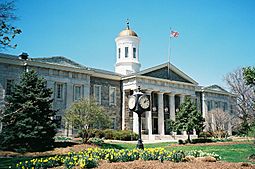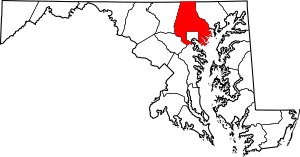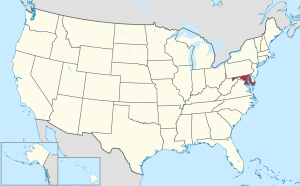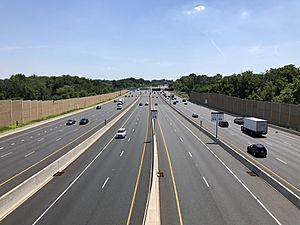Baltimore County, Maryland facts for kids
Quick facts for kids
Baltimore County
|
|||
|---|---|---|---|

The Baltimore County Courthouse
|
|||
|
|||
| Nickname(s):
"BalCo", "B-More County", "The County"
|
|||

Location within the U.S. state of Maryland
|
|||
 Maryland's location within the U.S. |
|||
| Country | |||
| State | |||
| Founded | June 30, 1659 | ||
| Named for | Cecil Calvert, 2nd Baron Baltimore | ||
| Seat | Towson | ||
| Largest community | Dundalk | ||
| Area | |||
| • Total | 682 sq mi (1,770 km2) | ||
| • Land | 598 sq mi (1,550 km2) | ||
| • Water | 83 sq mi (210 km2) 12% | ||
| Population
(2020)
|
|||
| • Total | 854,535 | ||
| • Estimate
(2023)
|
844,703 |
||
| • Density | 1,253.0/sq mi (483.8/km2) | ||
| Time zone | UTC−5 (Eastern) | ||
| • Summer (DST) | UTC−4 (EDT) | ||
| Congressional districts | 1st, 2nd, 7th | ||
Baltimore County is the third-largest county by population in the state of Maryland. It is located in the central part of Maryland. Baltimore County surrounds, but does not include, the separate city of Baltimore. It is part of a very large group of cities and towns called the Northeast megalopolis. This area stretches from Northern Virginia all the way to Boston. It includes major cities like New York City and Philadelphia.
Important parts of the county's economy include education, government, and health care. In 2020, about 854,535 people lived here. Baltimore County is home to several universities. These include Goucher College, Stevenson University, Towson University, and University of Maryland, Baltimore County.
Contents
History of Baltimore County
How Baltimore County Started
The name "Baltimore" comes from Cecil Calvert, 2nd Baron Baltimore. He was the owner of the Maryland colony a long time ago. The name also comes from a town in County Cork, Ireland. The first official record of the county is from January 12, 1659. This is when a special order was sent to its sheriff.
The county was officially started in 1659. It is now one of 23 counties in Maryland. When it was first created, Baltimore County was much bigger than it is today. It covered most of northeastern Maryland. This area was the edge of the colony at the time. It included what are now Baltimore City, Cecil County, and Harford County. Parts of Carroll, Anne Arundel, Frederick, Howard, and Kent Counties were also part of it.
Over the years, parts of the original Baltimore County were separated to create new counties. This happened as more people moved into those areas. For example, Cecil County was formed in 1674. Frederick County was created in 1748. Harford County was split off in 1773. Later, in 1837, part of Baltimore County helped form Carroll County. Finally, Howard County became separate in 1851.
Early County Seats
Before 1674, Baltimore County court meetings were held in people's homes. In 1674, a law was passed to build a courthouse and prison in each county. The first county seat for Baltimore County was called "Old Baltimore." It was located near the Bush River. This area later became part of Harford County in 1773.
Today, the exact spot of Old Baltimore is Chilbury Point. It is on land that belongs to the Aberdeen Proving Ground. This is a testing facility for the U.S. Army. In the late 1990s, experts looked for Old Baltimore. They found old artifacts like coins and gun flints. They also found the remains of an old tavern.
In 1683, a law was passed to create towns and trading ports. One of these towns was "on Bush River, near the Court-House." This was likely the courthouse built in 1674. By 1695, the "Old Baltimore" courthouse was no longer used. A new courthouse was being built near the Little Gunpowder Falls.
Moving to Joppa and Baltimore City
By 1700, the county seat moved to Joppa. This showed that the Gunpowder River area was becoming more important for business. By 1724, Joppa had about 50 houses, a church, a courthouse, and stores. It also had a public dock.
Another important port was Elkridge Landing on the Patapsco River. It was a busy place where large barrels of tobacco were loaded onto ships. But over time, the river became too shallow due to dirt washing into it. So, the port's importance faded. Later, it became a stop on the Baltimore and Ohio Railroad.
In 1768, the county seat moved again, this time to the growing port town of Baltimore. The first courthouse in Baltimore was built in 1768. It was located where Battle Monument Square is today.
Separation from Baltimore City
The city of Baltimore became its own separate city in 1796–1797. However, it remained part of Baltimore County and was its county seat until 1851.
The Battle Monument was built between 1815 and 1822. It remembers the city and county's defense during the War of 1812. This included the attack on Fort McHenry and the Battle of North Point. These events are celebrated every year on September 12, called Defenders Day.
In 1851, Baltimore City officially separated from Baltimore County. This made Baltimore one of the few "independent cities" in the United States. It meant the city was on the same level as the state's other 23 counties.
Towsontown was chosen as the new county seat in 1854. Baltimore City continued to take land from the county in 1888 and again in 1918–1919. After 1948, a new rule was put in place. It said that no more land could be taken from the county without the approval of the people living there.
Modern Era
A new Baltimore County Courthouse was built in Towson in 1855. It was made of local stone. Over the years, more parts were added to it. By the 1970s, a separate modern building was built for the county's legal system.
Over time, the city and county have learned to work together more. They now share some government agencies and state districts. Many historical places in Baltimore County are listed on the National Register of Historic Places. This list helps protect important sites.
Geography
Baltimore County covers about 682 square miles. About 598 square miles of this is land, and 83 square miles (12%) is water. It is the third-largest county in Maryland by land area. Most of the county has hills. These hills often rise to about 800 feet above sea level.
The highest point in the county is about 960 feet above sea level. It is near Maryland's border with Pennsylvania near Steltz. The lowest point is at sea level along the shore of Chesapeake Bay.
Much of the county is suburban. This means it has many towns and neighborhoods outside a big city. It sits between the Piedmont plateau in the northwest and the Atlantic coastal plain in the south. Northern Baltimore County is mostly rural. It has rolling hills and forests, similar to nearby Carroll County and Harford County.
Climate
Baltimore County has a humid subtropical climate. This means it has hot, humid summers and mild winters. In the northern parts, it can be a hot-summer humid continental climate. Average monthly temperatures in Towson range from about 33°F in January to 77°F in July.
Neighboring Areas
Baltimore County shares borders with these places:
- York County, Pennsylvania (north)
- Carroll County (west)
- Harford County (east)
- Anne Arundel County (south)
- Kent County (Southeast)
- Howard County (southwest)
- Baltimore City (south)
Protected Natural Areas
- Hampton National Historic Site
- Soldiers Delight Natural Environment Area
Transportation
Major Roads and Highways
 I-70
I-70 I-83
I-83 I-95
I-95 I-195
I-195 I-695
I-695 I-795
I-795 I-895
I-895 US 1
US 1
 US 1 Alt.
US 1 Alt. US 40
US 40 MD 7
MD 7 MD 25
MD 25 MD 26
MD 26 MD 30
MD 30 MD 41
MD 41 MD 43
MD 43 MD 45
MD 45 MD 88
MD 88 MD 91
MD 91 MD 122
MD 122 MD 125
MD 125 MD 129
MD 129 MD 130
MD 130 MD 131
MD 131 MD 133
MD 133 MD 134
MD 134 MD 137
MD 137 MD 138
MD 138 MD 139
MD 139 MD 140
MD 140 MD 144
MD 144 MD 145
MD 145 MD 146
MD 146 MD 147
MD 147 MD 150
MD 150 MD 151
MD 151 MD 165
MD 165 MD 166
MD 166 MD 295
MD 295 MD 372
MD 372 MD 439
MD 439 MD 542
MD 542 MD 562
MD 562 MD 648
MD 648 MD 695
MD 695 MD 700
MD 700 MD 702
MD 702 MD 940
MD 940
Public Transportation
The Maryland Transit Administration (MTA) runs three train systems in the Baltimore area. All of them have stops in Baltimore County. The Metro SubwayLink goes northwest from the city to Owings Mills. The Light RailLink goes north to Hunt Valley and south through Baltimore Highlands. Some routes end at Baltimore/Washington International Thurgood Marshall Airport. Commuter train service, called MARC Train, is available at stations like Halethorpe and Martin State Airport.
The MTA also has local and regional bus services that serve Baltimore County.
Railroads
Both CSX Transportation and Amtrak have major train lines that run through Baltimore County. In the past, other lines like the Maryland and Pennsylvania Railroad and the Northern Central Railway also ran through the county. Parts of these old lines are now used for other things. For example, the Light Rail uses part of the Northern Central line. Another part of the Northern Central line has been turned into a popular path for hiking, biking, and jogging. It is called the Torrey C. Brown Rail Trail.
Population Information
| Historical population | |||
|---|---|---|---|
| Census | Pop. | %± | |
| 1790 | 38,937 | — | |
| 1800 | 59,030 | 51.6% | |
| 1810 | 75,780 | 28.4% | |
| 1820 | 96,201 | 26.9% | |
| 1830 | 120,870 | 25.6% | |
| 1840 | 134,379 | 11.2% | |
| 1850 | 210,646 | 56.8% | |
| 1860 | 54,135 | −74.3% | |
| 1870 | 63,387 | 17.1% | |
| 1880 | 83,336 | 31.5% | |
| 1890 | 72,909 | −12.5% | |
| 1900 | 90,755 | 24.5% | |
| 1910 | 122,349 | 34.8% | |
| 1920 | 74,817 | −38.8% | |
| 1930 | 124,565 | 66.5% | |
| 1940 | 155,825 | 25.1% | |
| 1950 | 270,273 | 73.4% | |
| 1960 | 492,428 | 82.2% | |
| 1970 | 621,077 | 26.1% | |
| 1980 | 655,615 | 5.6% | |
| 1990 | 692,134 | 5.6% | |
| 2000 | 754,292 | 9.0% | |
| 2010 | 805,029 | 6.7% | |
| 2020 | 854,535 | 6.1% | |
| 2023 (est.) | 844,703 | 4.9% | |
| Population before 1860 includes town and (1797) city of Baltimore. Population decline in 1890 and 1920 census figures reflect annexations by the City of Baltimore. 1790–1960 1900–1990 1990–2000 2010 2020 |
|||
2020 Census Details
The 2020 census showed that the population of Baltimore County was 854,535 people. The table below shows the different racial and ethnic groups living in the county.
| Race / Ethnicity (NH = Non-Hispanic) | Pop 2010 | Pop 2020 | % 2010 | % 2020 |
|---|---|---|---|---|
| White alone (NH) | 504,556 | 443,263 | 62.68% | 51.87% |
| Black or African American alone (NH) | 206,913 | 252,724 | 25.70% | 29.57% |
| Native American or Alaska Native alone (NH) | 2,107 | 1,942 | 0.26% | 0.23% |
| Asian alone (NH) | 39,865 | 54,701 | 4.95% | 6.40% |
| Pacific Islander alone (NH) | 255 | 252 | 0.03% | 0.03% |
| Some Other Race alone (NH) | 1,445 | 4,461 | 0.18% | 0.52% |
| Mixed Race or Multi-Racial (NH) | 16,153 | 35,700 | 2.01% | 4.18% |
| Hispanic or Latino (any race) | 33,735 | 61,492 | 4.19% | 7.20% |
| Total | 805,029 | 854,535 | 100.00% | 100.00% |
2010 Census Details
In 2010, there were 805,029 people living in Baltimore County. There were 316,715 households and 205,113 families. The population density was about 1,345 people per square mile. The average household had 2.48 people, and the average family had 3.04 people. The average age of people in the county was 39.1 years.
The median income for a household was $63,959. For a family, it was $78,385. The per person income for the county was $33,719. About 8.1% of the population lived below the poverty line. This included 10.1% of those under 18 years old.
Economy
Baltimore County has many important employers. These include MedStar Franklin Square Medical Center and the Social Security Administration. The national headquarters for the Social Security Administration is in Woodlawn. The Black & Decker Corporation is also a major employer in Towson.
In 2009, about 410,100 people worked in the county. About 25% of these jobs were in education, health, and human services. About 10% were in retail stores. Less than 1% of jobs were in agriculture.
Top Employers
The biggest employers in Baltimore County are mostly in government, healthcare, and education. Here are the top 10 employers from 2011:
| # | Employer | # of Employees |
|---|---|---|
| 1 | Social Security Administration/CMS | 14,948 |
| 2 | Baltimore County Public Schools | 14,608 |
| 3 | Baltimore County | 8,429 |
| 4 | MedStar Franklin Square Medical Center | 3,500 |
| 5 | Towson University | 3,344 |
| 6 | Greater Baltimore Medical Center | 3,331 |
| 7 | St. Joseph Medical Center | 3,330 |
| 8 | University of Maryland, Baltimore County | 3,258 |
| 9 | Erickson Living | 3,070 |
| 10 | The Sheppard and Enoch Pratt Hospital | 2,380 |
Farming and Agriculture
The University of Maryland Extension system helps farmers in the county. The state Farm Bureau also supports farming here. They provide information and resources to help with farming practices.
Education
Colleges and Universities
The University System of Maryland has two universities in Baltimore County:
- Towson University in Towson. It was founded in 1866.
- University of Maryland, Baltimore County in Catonsville. It was founded in 1966.
There are also two private colleges in Baltimore County:
- Goucher College (in Towson). It was founded in 1885.
- Stevenson University (campuses in Stevenson and Owings Mills).
Other schools with a campus in Baltimore County include:
- Loyola College in Maryland (in Hunt Valley).
- The Community College of Baltimore County (CCBC). It has campuses in Catonsville, Essex, and Dundalk.
Public Schools
All public schools in Baltimore County are run by Baltimore County Public Schools. This is the only school district in the county. One exception is the Imagine Me Charter School, which opened in 2008.
Private Schools
Baltimore County has many private schools for students from kindergarten to 12th grade. Some of these schools are:
- Arlington Baptist High School
- Baltimore Actors Theatre Conservatory
- Beth Tfiloh Dahan Community School
- The Boys' Latin School of Maryland
- Calvert Hall College High School
- Cambridge School of Baltimore
- Concordia Preparatory School
- Garrison Forest School
- Immaculate Conception School
- Jemicy School
- Loyola Blakefield
- Maryvale Preparatory School
- McDonogh School
- Mount de Sales Academy
- Notre Dame Preparatory School
- Oldfields School (all-girls')
- Our Lady of Grace School
- Our Lady of Mt. Carmel
- The Park School
- St. James Academy in Monkton
- St. Paul's School & St. Paul's School for Girls
- St. Timothy's School (all-girls')
Communities
Baltimore County has many communities. None of these communities are officially separate cities or towns. They are all part of the county government.
Census-Designated Places
These are areas that the U.S. Census Bureau recognizes for gathering population data:
- Arbutus
- Baltimore Highlands
- Bowleys Quarters
- Carney
- Catonsville
- Cockeysville
- Dundalk
- Edgemere
- Essex
- Garrison
- Hampton
- Kingsville
- Lansdowne
- Lochearn
- Lutherville
- Mays Chapel
- Middle River
- Milford Mill
- Overlea
- Owings Mills
- Parkville
- Perry Hall
- Pikesville
- Randallstown
- Reisterstown
- Rosedale
- Rossville
- Timonium
- Towson (county seat)
- White Marsh
- Woodlawn
Other Communities
These communities are well-known locally. Many have their own post offices and appear on maps:
- Baldwin
- Boring
- Bradshaw
- Brooklandville
- Butler
- Chase
- Fork
- Fort Howard
- Germantown
- Glen Arm
- Glencoe
- Glyndon
- Halethorpe
- Hereford
- Hunt Valley
- Hydes
- Jacksonville
- Long Green
- Maryland Line
- Monkton
- Nottingham
- Oella
- Parkton
- Phoenix
- Ruxton
- Sparks
- Sparrows Point
- Stevenson
- Trump
- Turners Station
- Upper Falls
- Upperco
- White Hall
Notable People
Many famous people have lived in or are from Baltimore County:
- Spiro Agnew, former Vice President of the United States
- All Time Low, punk-rock band
- Peter Angelos, owner of the Baltimore Orioles
- Mario Dewar Barrett, R&B singer
- A. J. Burnett, MLB pitcher
- David Byrne, lead singer of Talking Heads
- Tom Clancy, author
- Kevin Clash, puppeteer (Elmo from Sesame Street)
- Samuel Durrance, astronaut/physicist
- Robert Ehrlich, former Governor of Maryland
- Jane Frank, artist
- Jim Gentile, former baseball player
- Ira Glass, host of This American Life
- Stacy Keibler, actress and model
- Bucky Lasek, skateboarder
- Carol Mann, golfer
- Jamie Miller, drummer for Bad Religion
- Jim McKay, ABC-TV sportscaster
- Sid Meier, computer programmer (video games)
- Glenn Milstead, known as the actor "Divine"
- Mo'Nique, comedian and actress
- Jim Palmer, former Baltimore Oriole and Hall of Fame pitcher
- Michael Phelps, Olympic Gold-Medalist swimmer
- Rosa Ponselle, opera singer
- Robin Quivers, radio personality
- Angel Reese, women's basketball player
- Brooks Robinson, former Baltimore Oriole and Hall of Fame third baseman
- Mike Rowe, TV show host for Dirty Jobs
- Don Shula, former Baltimore Colts player and coach of the Miami Dolphins
- Pam Shriver, professional tennis player
- Johnny Unitas, former Baltimore Colt and Hall of Fame quarterback
- Nikolai Volkoff, professional wrestler
- John Waters, filmmaker
See also
 In Spanish: Condado de Baltimore para niños
In Spanish: Condado de Baltimore para niños




